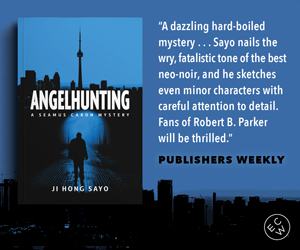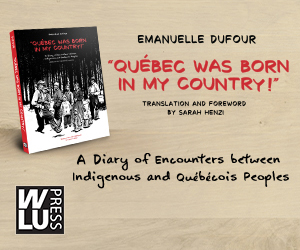The In Character interview, with Heather Tucker
Heather Tucker's debut novel The Clay Girl (ECW Press) marks the arrival of a writer who will make you impatient for the next book. Confident, lyrical, tough, and populated by unforgettable characters, The Clay Girl begins with the dysfunctional patriarch of the Appleton clan shooting himself, throwing the lives of his six daughters into disarray. We follow eight-year-old Hariet ("Ari") on her harrowing journey from semi-orphan to complicated, clever young woman, watching as she dodges the malevolent influence of her mother along the way. Ari is witty, raw, and relatable even in her remarkable circumstances, and we're excited to welcome Heather to Open Book today to talk about Ari as part of our In Character interview series.
Heather tells us about the death in the novel that surprised even her (and the one she couldn't bear to leave in), the significance of Hariet's (misspelled) name, and blurring the line between writer and character.
Open Book:
Tell us about the main character in your new book.
Heather Tucker:
Perhaps the best way to tell you about Hariet (Ari) Appleton is through characters in the book. To her aunts, Ari is clay, not dirt. To her teachers, she’s more worth than trouble. The instant I met this imaginative eight-year-old, I knew she’d take me on an extraordinary journey.
Ari is quirky, creative, and very bright. When most children have long abandoned imaginary friends, hers, Jasper, gets stronger as Ari invents ways to cope with the trauma in her life. Despite her twisted mother and despicable father there is a wobbly balance and delightful pragmatism about her: “When you’re the youngest of six, you get what you get and most times you don’t.”
OB:
Some writers feel characters take on a “life of their own” during the writing process. Do you agree with this, or is a writer always in control?
HT:
For most of my life I “worked” with words, doing technical writing: curricula, policy, reports, resources… When I started writing fiction, work turned into play. The best part of playing with words is letting all my characters take flight. I watch and record what is happening. I get nosy. What is in their pockets? Who is following them? How do they feel under their skin? I explore their inner and outer spaces, I pull in my personal and professional experiences, but rarely, very rarely, do I plot.
There is a death of a character in The Clay Girl that I didn’t know was coming. It hit me like a punch and I wanted to rewrite it, but it was part of story and it belonged. Many times, Ari was spiralling and I thought a big crash would have “literary” impact, but she pulled out of the spin. I took my hands off and let her evolve into the person she wanted to become.
However, I confess to invoking writer-as-god when, during a robbery, Ari’s dog was killed. I hit the undo key so fast his tail was wagging before the horror of it hit my gut.
OB:
How do you choose names for your characters?
Your CanLit News
Subscribe to Open Book’s newsletter to get local book events, literary content, writing tips, and more in your inbox
HT:
A name is a weighty thing. The history of why or how our name was bestowed follows us our entire lives. Hariet is not a pretty name, especially when it’s misspelled. It could be a proud name, if it belonged to a beloved relative, but this “Hariet” was given out of spite.
All of Ari’s sisters have poetical names that begin with “J.” Their names evolved as I got to know them, but having each one start with the letter “J” was deliberate to show Hariet’s exclusion and alienation by her mother.
Sometimes a character arrives in my head fully named, but more often the name evolves and sometimes it’s like discovering a treasure — like her aunt finding “Nia” inside the disliked moniker “Eugenia” and Hariet discovering “Ari” inside “Hariet.”
I believe we become the names we call ourselves and I loved watching Ari grow fearlessly into a name meaning “lion-eagle,” coming to believe that she was Ari Joy Zajac, not the one-"r" Hariet her mother produced.
OB:
What is your approach to crafting dialogue, particularly for your main character? Do you have any tips about writing dialogue for aspiring and emerging writers?
HT:
I listen to my characters and transpose, more than craft. There is a wonderful energy in stories rich with dialogue, so I naturally gravitate to dialogue in my writing. When a “he said” is essential to identify the speaker, I prefer using a sensual detail like, Adam fumbled with the button on her blouse, or, Anna looked at the slush puddling around my boot…
Listening, or more eavesdropping, is essential in developing skill in writing dialogue. I especially like conversations that happen behind me, like on a bus, where I can listen “blind” and colour-in what the people talking look like. I pay attention to tone, pauses, subtext, inflection, word choices, and more.
And for me, reading aloud is critical. When I’m reading any story and come across a line that startles me, I will turn it on my tongue to see what made it so special. I read my work out loud on three levels: to myself, to another person, and to my critique group. If I can’t speak it easily to myself then I work on it until it feels natural. Speaking it to a reader shifts my focus to how another person might hear it. I find this helps shave off the formality that often creeps into written dialogue. And then I offer it up for critique and trust the collective wisdom of my small writing group.
OB:
Do you have anything in common with your main character? What parts of yourself do you see in him or her, and what is particularly different?
HT:
When it comes to writing, I admit to having “multiple personality disorder.” I get so enmeshed in the characters, that I’m in their heads and they’re in mine and my reality blends with invented worlds. I have much in common with all of my characters, both the divine and devilish, from hero and rescuer to messed-up, self-serving villain.
That being said, I am intrinsically connected to Ari through Jasper, that voice in me whispering under the negative din, Imagine this! Look, just look. Yes you can. Leap! You’re clay, not dirt. You’re more worth than trouble. Without that little voice encouraging me I would have, long ago, just stayed in bed.
OB:
Who are some of the most memorable characters you've come across as a reader?
HT:
How does a writer answer this question? It’s like asking a person rich with spectacular friends to say which one of them is their favourite. I have a legion of memorable characters, each having enriched my life in different ways and at different times. So, I think I will answer this by sharing a few of my oldest friends. Inventive, spirited Pippi Longstocking; as a little girl her world was my escape when I most needed one. In my teens and twenties, Mick Kelly from The Heart is a Lonely Hunter and The Stone Angel’s Hagar Shipley got under my skin, because they so intimately invited me into their inner-spaces. And, though not fiction, Anne Frank has been an inspiration to me for over fifty years.
OB:
What are you working on now?
HT:
Two projects have me happily engaged right now. Smoking Water is a novel set in Ethiopia in 1974. It’s a story of a young Canadian nurse who in the midst of famine and political upheaval finds her greatest threat to be a sociopathic missionary who has claimed rights to her.
And I’m polishing Cracked Pots, the sequel to The Clay Girl, which follows Ari Appleton from the age of 16 to 23.
_________________________________________________________
Heather Tucker has won many prose and short-story writing competitions, and her stories have appeared in anthologies and literary journals. She lives in Ajax, Ontario.




